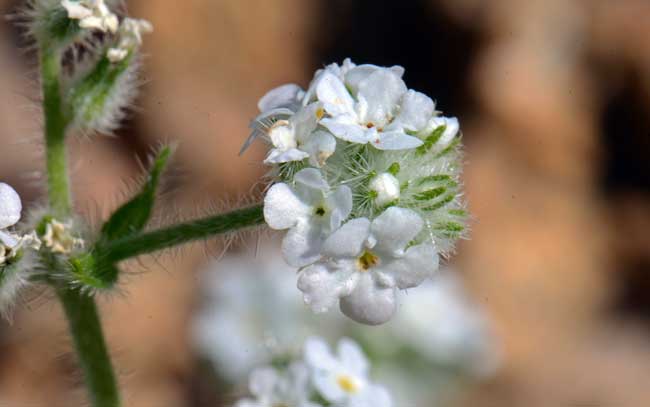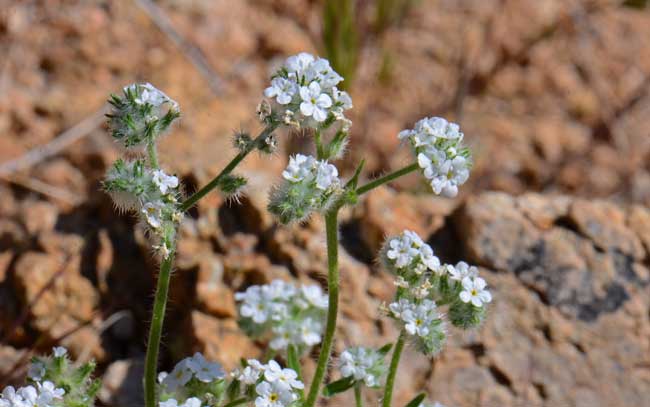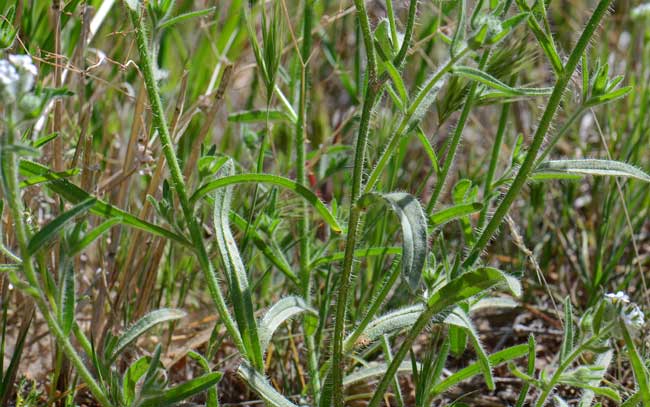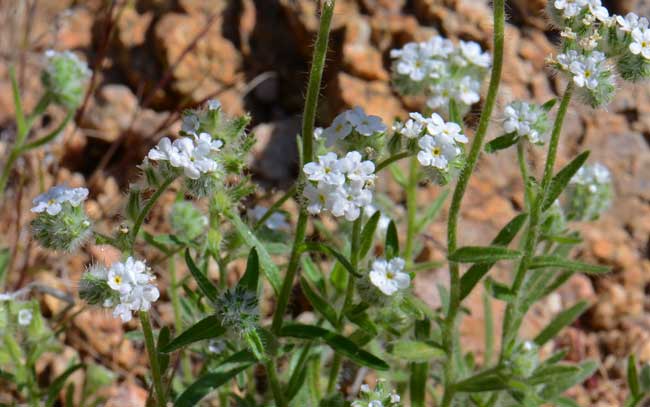Cryptantha gracilis, Narrowstem Cryptantha




Scientific Name: Cryptantha gracilis
Common Name: Narrowstem Cryptantha
Also Called: Narrowstem Catseye, Narrow-Stem Cat's-Eye, Narrowstem Pick-Me-Not, Slender Cryptantha
Family: Boraginaceae, Forget-Me-Not Family
Synonyms: (Cryptantha hillmanii, Cryptantha linearis)
Status: Native
Duration: Annual
Size: 4 to 14 inches (10-35 cm) tall.
Growth Form: Forb/herb; plants slender; decumbent to erect; branches zero or multiple throughout; straight, stiff hairs, (strigose).
Leaves: Green; leaves ⅓ to 1⅓ inches (1-3.5 cm); leaf shape very narrow (linear) to narrow-oblanceolate; leaves also dense-bristly.
Flower Color: White, bright white with yellow secondary parts (appendages) in center of corolla; flowering stems inflorescence a cyme curved like a scorpion tail (scorpioid); fruit a nutlet, generally 1 seed.
Flowering Season: March, April or May to June or July
Elevation: 1,500 to 7,000 feet (450-2100 m).
Habitat Preferences: Sandy to rocky soils, dry slopes, mesas, frequently on limestone; in Creosote Bush, Sagebrush, Joshua-tree and Pinyon-juniper communities.
Recorded Range: Narrowstem Cryptantha is found in the southwest and northwest portions of United States in; AZ, CA, CO, ID, NM, NV, OR, UT, WA and WY.
North America & US County Distribution Map for Cryptantha gracilis.
U.S. Weed Information: No data available.
Invasive/Noxious Weed Information: No data available.
Wetland Indicator: No data available.
Threatened/Endangered Information: No data available.
In the Southwestern United States: Arizona has 37 species of genus, California has 60 species, Nevada has 44 species, New Mexico has 23 species, Texas has 15 species, Utah has 55 species. All data approximate and subject to revision.
The genus Cryptantha was published by Johann Georg Christian Lehmann in 1837.
Comments: Members of the genus Cryptantha are collectively referred to as Cat’s Eyes or Popcorn Flowers. There are many species of Cryptantha in Arizona all with similar taxonomic characteristics making them difficult to identify to species. Many can be spotted blooming in spring or early summer.
Cryptantha species have typically white flowers in spikes like a scorpions (scorpioid) tail. They are often difficult to identify in the field or lab and a close examination (10x loupe or dissecting scope) of the flowers and the small seeds or nutlets is usually required.
Narrowstem Cryptantha is similar to Fendler's Cryptantha, Cryptantha fendleri, however Fendler's Cryptantha has a more open flowering stem (inflorescence), the outer whorl of the flower (the calyx) is rounded and there are 4 nutlets.
In Southwest Desert Flora also see Bearded Cryptantha, Cryptantha barbigera, Gander's Cryptantha, Cryptantha ganderi, Panamint Cryptantha, Johnstonella angustifolia, Redroot Cryptantha, Cryptantha micrantha, Torrey's Cryptantha, Cryptantha torreyana, and Wingnut Cryptantha, Cryptantha pterocarya.
The species epithet "gracilis" (gra'cile:) meaning slender and graceful.

